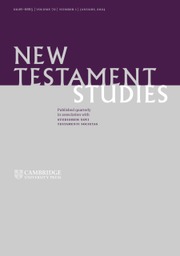https://www.gorgiaspress.com/scribal-habits-in-near-eastern-manuscript-traditions
Overview: The paratextual elements of Near Eastern manuscripts are the focus of Scribal Habits in Near Eastern Manuscript Traditions. These elements, such as annotations, colophons, illustrations, diacritical signs, and commentaries are often overlooked by those interested in biblical studies because of an emphasis on a manuscript’s main literary text. This tendency is understandable given evangelicals' commitment to the text of Scripture but neglecting these paratextual elements ultimately obscures a fuller and more complete understanding of these manuscripts and the texts they transmit. This book, Scribal Habits, highlights these features to provide readers with the ability to ‘“virtually look over the scribes’ shoulder” (xiii; a slight rephrase of the words of J. R. Royse).
Here is a sampling of the book’s content. Elizabeth Buchanan concluded in her chapter that the use of the diaeresis in Byzantine Egypt evinces patterns. One of these patterns is that the “more accomplished writers” used the sign most consistently (23). Binyamin Katzoff studied the chapter divisions in the Tosefta and concluded that the divisions in the E tradition corresponded with the divisions of the Mishna. This study provides insight into how one tradition could be influenced by another literary work: in this case, the Mishna (102). Katzoff’s second chapter of the book investigated how a text could be systematically corrected to a text of an alternative textual tradition (112). This summary suffices to show the importance of these features, especially for evangelicals when studying biblical texts. Our assessment of the biblical text has to consider these features.
Application to OT Textual Criticism: As a biblical scholar, in particular, a textual critic primarily concerned with the Dead Sea Scrolls, two topics of this book intrigued me. First, I was interested to learn about the significance of the paratextual elements in Near Eastern manuscripts since several of these elements are also present in the Dead Sea Scrolls. For example, diacritical signs are used in some manuscripts such as the margins of 1QIsaa and 4QCantb, 1QIsaa may preserve a marginal gloss, and a drastic shift in paleography occurs in 4QJosha. Moreover, there is a shift from poetry to prose in 11QPsa. Given the use of these features in the Dead Sea Scrolls, I was interested in how these paratextual elements functioned in other texts of this region.
Second, I hoped that this book would help me ask different questions about the Dead Sea Scrolls and open new avenues of study for me. This task is comparative. That is, I hoped to compare these mostly later more extant manuscripts and their signs and features to the earlier less extant Dead Sea Scrolls.
Before I engage in this comparative task, it is helpful to mention a few difficulties with this process. Perhaps the most profound difficulty in comparing these later Near Eastern manuscripts to the Dead Sea Scrolls is that the Dead Sea Scrolls exist in a highly fragmentary state. Anyone familiar with this discipline understands this reality, and it can easily be illustrated by turning to the back of a DJD volume and observing the PAM plates. One can also see this reality by exploring “The Leon Levy Dead Sea Scrolls Digital Library” accessed here https://www.deadseascrolls.org.il/home. Many Dead Sea fragments are unidentified, and some are only probably identified (see the debate around 4Q118, for example). This reality complicates an investigation into the paratextual elements of the Dead Sea Scrolls since many upper, lower, and intercolumnar margins have decayed. Handle sheets, title pages, and the endings of most manuscripts have deteriorated into dust. What precious information that these columns of parchment once contained is now lost, regrettably so, so that scholars can only dream of what a now lost colophon might have contributed to our understanding of these manuscripts.
Another difficulty with this process is the chronological and cultural gap between the Scrolls and the texts analyzed in Scribal Habits. For example, the Dead Sea Scrolls are usually earlier than the manuscripts discussed here although there is at least one exception to this (see Szilvia Sövegjártó’s chapter on the Sumerian texts from the Old Babylonian era). Scribal habits, and the paratextual elements that they utilized, may not have remained static. The same can be said of the cultural differences between ancient Jews and the cultures of the scribes who preserved the manuscripts discussed in Scribal Habits. These realities, likewise, might complicate the comparative task.
Despite these difficulties, I did enjoy comparing these texts to the Dead Sea Scrolls. Here are some thoughts regarding one of the chapters. T. C. Schmidt discussed the reception history of the Book of Revelation in Eastern churches, and in particular, the scribal strategies that might indicate a scribe's general assessment of the book. For example, the material used for writing, the books to which Revelation was bound, and the writing style of the scribe were all strategies that might demonstrate the scribe's attitude about the book’s status.
These insights provided me with interesting questions to ask of the Dead Sea Scrolls such as Does the quality of the script have any effect on a book’s status? Is there any connection between expertly copied texts and the status of the texts preserved in these manuscripts? Here I am thinking of what Tov labels de luxe edition manuscripts (see Scribal Approaches, 125-129). What does the phenomenon of stitching biblical and nonbiblical texts together signify about these texts’ status? This question continues to be an important issue regarding 11QPsa. Although most of the Dead Sea Scrolls are copied on parchment, what does the use of papyrus signify if anything during the Second Temple period? This distinction was significant in rabbinic literature. Is there a correspondence between the orthographic profile of a manuscript and the manuscript’s paleographic style? This one chapter demonstrates the importance of Scribal Habits for those interested in the history of ancient manuscripts including manuscripts that preserve the biblical text.









